仁爱版九年级英语教学设计.doc
- 格式:doc
- 大小:35.00 KB
- 文档页数:6
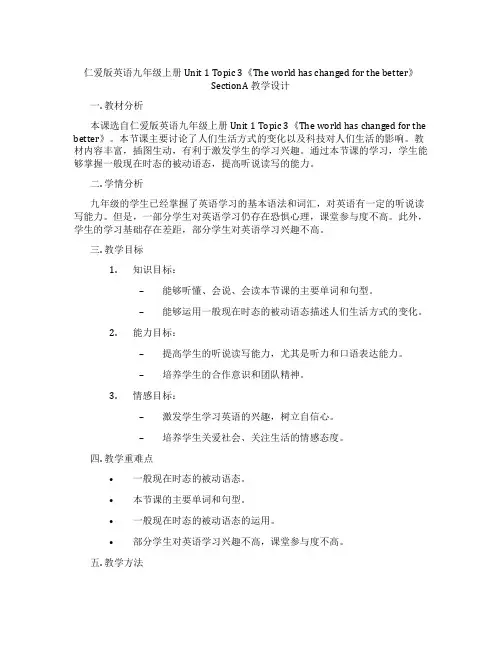
仁爱版英语九年级上册Unit 1 Topic 3《The world has changed for the better》SectionA 教学设计一. 教材分析本课选自仁爱版英语九年级上册Unit 1 Topic 3《The world has changed for the better》。
本节课主要讨论了人们生活方式的变化以及科技对人们生活的影响。
教材内容丰富,插图生动,有利于激发学生的学习兴趣。
通过本节课的学习,学生能够掌握一般现在时态的被动语态,提高听说读写的能力。
二. 学情分析九年级的学生已经掌握了英语学习的基本语法和词汇,对英语有一定的听说读写能力。
但是,一部分学生对英语学习仍存在恐惧心理,课堂参与度不高。
此外,学生的学习基础存在差距,部分学生对英语学习兴趣不高。
三. 教学目标1.知识目标:–能够听懂、会说、会读本节课的主要单词和句型。
–能够运用一般现在时态的被动语态描述人们生活方式的变化。
2.能力目标:–提高学生的听说读写能力,尤其是听力和口语表达能力。
–培养学生的合作意识和团队精神。
3.情感目标:–激发学生学习英语的兴趣,树立自信心。
–培养学生关爱社会、关注生活的情感态度。
四. 教学重难点•一般现在时态的被动语态。
•本节课的主要单词和句型。
•一般现在时态的被动语态的运用。
•部分学生对英语学习兴趣不高,课堂参与度不高。
五. 教学方法1.任务型教学法:通过小组合作、任务完成的方式,激发学生的学习兴趣,提高学生的参与度。
2.情境教学法:创设生活情境,让学生在真实的环境中学习英语,提高学生的语言运用能力。
3.激励性评价:注重鼓励学生,激发学生的自信心,让学生敢于开口说英语。
六. 教学准备1.教学课件:制作多媒体课件,包括图片、视频、音频等素材,丰富教学内容。
2.教学道具:准备相关的生活用品,如手机、电脑等,用于创设情境。
3.教学资源:收集相关的英语学习资料,为学生提供丰富的学习资源。
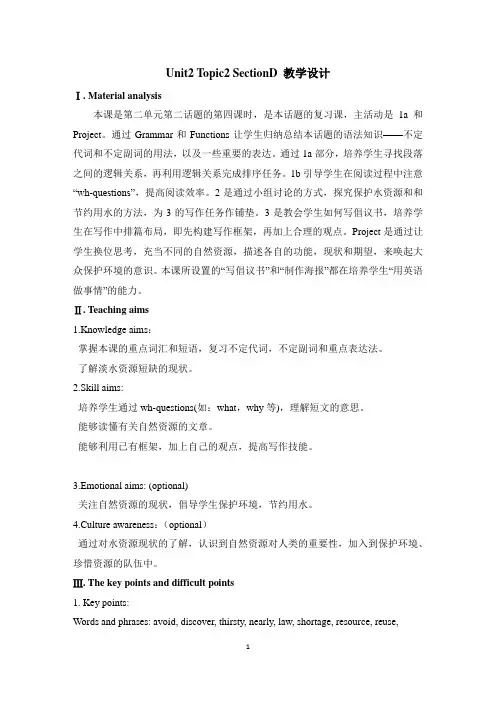
Unit2 Topic2 SectionD 教学设计Ⅰ. Material analysis本课是第二单元第二话题的第四课时,是本话题的复习课,主活动是1a和Project。
通过Grammar和Functions让学生归纳总结本话题的语法知识——不定代词和不定副词的用法,以及一些重要的表达。
通过1a部分,培养学生寻找段落之间的逻辑关系,再利用逻辑关系完成排序任务。
1b引导学生在阅读过程中注意“wh-questions”,提高阅读效率。
2是通过小组讨论的方式,探究保护水资源和和节约用水的方法,为3的写作任务作铺垫。
3是教会学生如何写倡议书,培养学生在写作中排篇布局,即先构建写作框架,再加上合理的观点。
Project是通过让学生换位思考,充当不同的自然资源,描述各自的功能,现状和期望,来唤起大众保护环境的意识。
本课所设置的“写倡议书”和“制作海报”都在培养学生“用英语做事情”的能力。
Ⅱ. Teaching aims1.Knowledge aims:掌握本课的重点词汇和短语,复习不定代词,不定副词和重点表达法。
了解淡水资源短缺的现状。
2.Skill aims:培养学生通过wh-questions(如:what,why等),理解短文的意思。
能够读懂有关自然资源的文章。
能够利用已有框架,加上自己的观点,提高写作技能。
3.Emotional aims: (optional)关注自然资源的现状,倡导学生保护环境,节约用水。
4.Culture awareness:(optional)通过对水资源现状的了解,认识到自然资源对人类的重要性,加入到保护环境、珍惜资源的队伍中。
Ⅲ. The key points and difficult points1. Key points:Words and phrases: avoid, discover, thirsty, nearly, law, shortage, resource, reuse,take sth. away from…, the shortage of water / water shortage, avoid (doing) sth., make progress in, nearly 3/4 of…2. Difficult points:学会归纳话题中的重点语法和表达法。
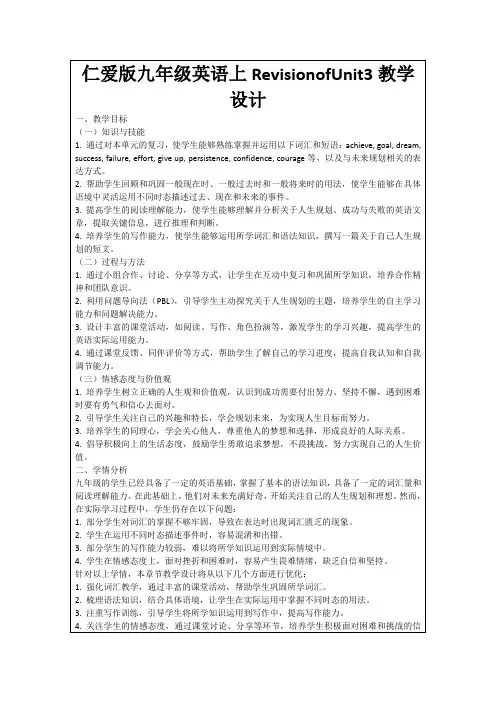
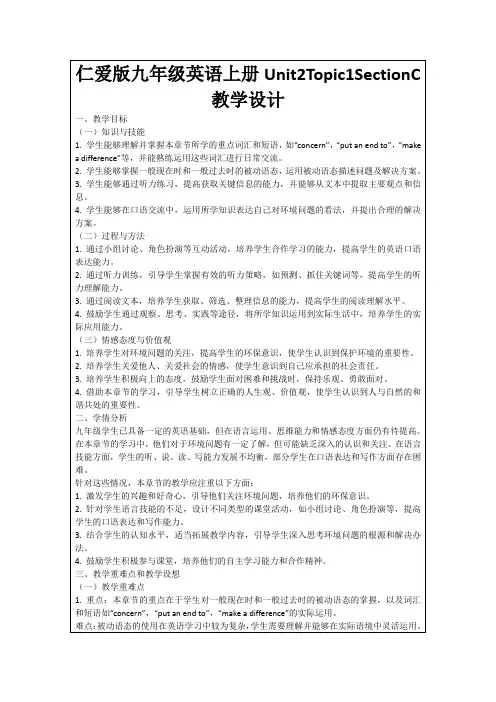
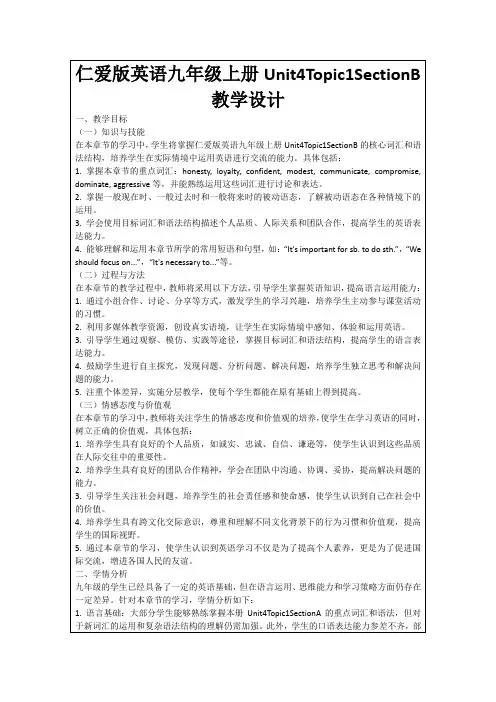
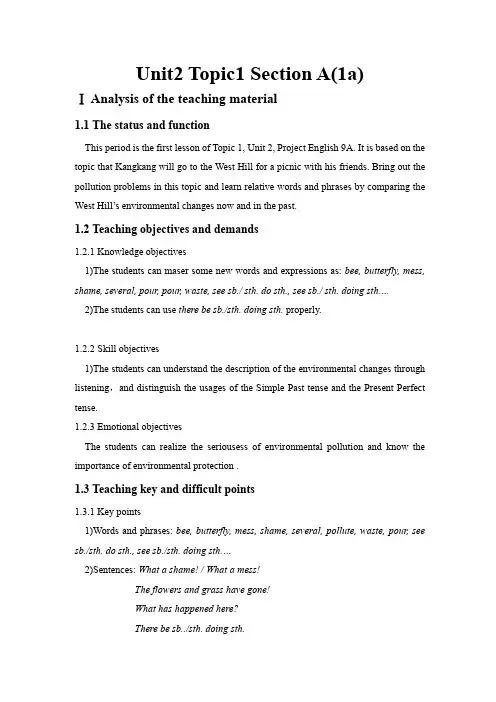
Unit2 Topic1 Section A(1a)Ⅰ Analysis of the teaching material1.1 The status and functionThis period is the first lesson of Topic 1, Unit 2, Project English 9A. It is based on the topic that Kangkang will go to the West Hill for a picnic with his friends. Bring out the pollution problems in this topic and learn relative words and phrases by comparing the West Hill’s environmental changes now and in the past.1.2 Teaching objectives and demands1.2.1 Knowledge objectives1)The students can maser some new words and expressions as: bee, butterfly, mess, shame, several, pour, pour, waste, see sb./ sth. do sth., see sb./ sth. doing sth.…2)The students can use there be sb./sth. doing sth. properly.1.2.2 Skill objectives1)The students can understand the description of the environmental changes through listening,and distinguish the usages of the Simple Past tense and the Present Perfect tense.1.2.3 Emotional objectivesThe students can realize the seriousess of environmental pollution and know the importance of environmental protection .1.3 Teaching key and difficult points1.3.1 Key points1)Words and phrases: bee, butterfly, mess, shame, several, pollute, waste, pour, see sb./sth. do sth., see sb./sth. doing sth.…2)Sentences: What a shame! / What a mess!The flowers and grass have gone!What has happened here?There be sb../sth. doing sth.There are several factories pouring waste water into the stream.Everything has changed.3)Grammar: differences between the Simple Past tense and the Present Perfect tense.1.3.2 Difficult points1)To use there be sb./sth. doing sth. properly.2)To distinguish see sb./sth. do sth. and see sb./sth. doing sth.Ⅱ Analysis of the studentsStudents in Grade Nine have some cognitive abilities and their own opinions. They are not satisfied with just the content of the textbooks but hope to get more information and widen their eyesight through textbooks. Therefore,we should not teach the knowledge directly but in a way students can take part in learning by themselves and communicate and cooperate with others, in which they can experience, practice and explore by themselves. So teachers should pay more attention to combine the reality of the students and the topic of the textbook to arouse students’ interest to make them find, gain and use the information they need. Meanwhile, teachers should create a open, harmonious and interactive atmosphere in the teaching environment,where students can exchange their opinions, discuss, cooperate and act and make dialogs freely, thus inspiring students’ potentials,getting knowledge through autonomous and cooperative studying, forming their own way of studying English and improving their English study.Ⅲ Analysis of the teaching methodsThe Task-based learning method and the Situational teaching method can increase the class efficiency, arouse the students’ learning interest and make the students learn about teamwork.Ⅲ Learning strategies4.1 Previewing before class is a good way of learning.4.2 Reading the listening material and predicting before listening are good learning habits.4.3 It is helpful to retell the statements in the dialog.Ⅲ Teaching aidsThe multimedia teaching system, chalks, blackboard, some gifts and PPT.Ⅲ Teaching proceduresFive teaching stages:Stage 1 Lead-in (3-5 mins)Stage 2 Pre-listening 10-12mins)Stage 3 While-listening (10-12 mins)Stage 4 Post-listening (10-12 mins)Stage 5 Assigning homework (3-5 mins)Stage 1 Lead-inStep 1 GreetStep 2 learn the new words.Purpose: Students can concentrate on the interesting topic and master the new words .Stage 2 Pre-listeningStep 1 Step 2 learn the new words.Purpose: Students can reading the new words .Stage 3 While-listeningStep 1 Listen to 1a, check the answers in 1b.Step 2 Let students read la aloud and understand the content of 1a.Step 3 listen again and finish the table in 1c independently.. Purpose: Students can master the new words and expressions and consolidate the usage of the Simple Past tense and the Present Perfect tense. Students can know how to express now and the past differently and solve the difficult points. Students’ listening abilities will be improved . What’s more, students will be ready for speaking and retelling.Stage 4 Post-listeningStep 1 Watch a video of 1a, then practice the dialog in groups. Later ask one group to present in classStep 2 Understand the importent phrases.Step 3 Do some related exercises together in class..Purpose: Students can get more detailed information through readingg,consolidate and make good use of what they have learned and develop their abilities of reading and speaking. To help students realize the importance of environmental protection. To prepare for the senior high school entrance examination by combining the oral practice and written exercises.Stage 5 Assigning homeworkStep 1 Sum up the important words, phrases and sentences together.Step 2 Assign the homework.1. Read 1a.2. Finish Section A in your workbook.3. Preview Section B. Purpose: Students will get consolidations by summary. Finish exercises and consolidate the abilities of speaking and using English..Ⅲ Blackboard designⅢ Teaching reflectionThe activities in class cover all the key and difficult points of this lesson, and they are designed as a chain, so the former one will be helpful for the next. The students’ performance in those activities and exercises can tell the teacher how well they have learnt about this lesson, so the teacher can plan the following lessons better. With the help of the various teaching and learning methods, the students’ learning interest and initiatives are aroused. And their ability of using English to communicate is also improved.。
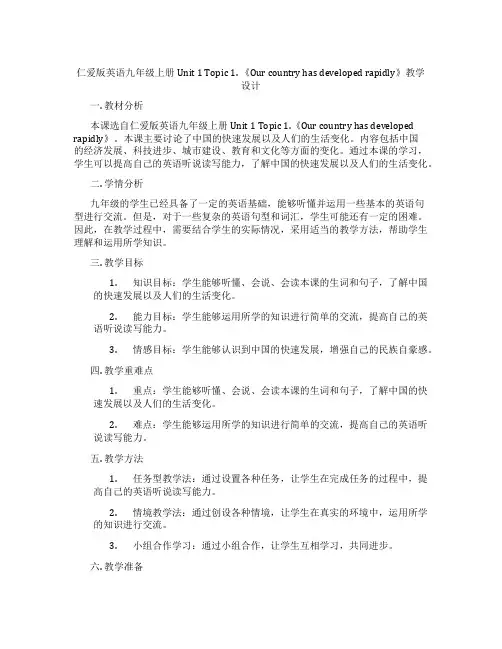
仁爱版英语九年级上册Unit 1 Topic 1. 《Our country has developed rapidly》教学设计一. 教材分析本课选自仁爱版英语九年级上册Unit 1 Topic 1.《Our country has developed rapidly》。
本课主要讨论了中国的快速发展以及人们的生活变化。
内容包括中国的经济发展、科技进步、城市建设、教育和文化等方面的变化。
通过本课的学习,学生可以提高自己的英语听说读写能力,了解中国的快速发展以及人们的生活变化。
二. 学情分析九年级的学生已经具备了一定的英语基础,能够听懂并运用一些基本的英语句型进行交流。
但是,对于一些复杂的英语句型和词汇,学生可能还有一定的困难。
因此,在教学过程中,需要结合学生的实际情况,采用适当的教学方法,帮助学生理解和运用所学知识。
三. 教学目标1.知识目标:学生能够听懂、会说、会读本课的生词和句子,了解中国的快速发展以及人们的生活变化。
2.能力目标:学生能够运用所学的知识进行简单的交流,提高自己的英语听说读写能力。
3.情感目标:学生能够认识到中国的快速发展,增强自己的民族自豪感。
四. 教学重难点1.重点:学生能够听懂、会说、会读本课的生词和句子,了解中国的快速发展以及人们的生活变化。
2.难点:学生能够运用所学的知识进行简单的交流,提高自己的英语听说读写能力。
五. 教学方法1.任务型教学法:通过设置各种任务,让学生在完成任务的过程中,提高自己的英语听说读写能力。
2.情境教学法:通过创设各种情境,让学生在真实的环境中,运用所学的知识进行交流。
3.小组合作学习:通过小组合作,让学生互相学习,共同进步。
六. 教学准备1.教材:仁爱版英语九年级上册2.多媒体教学设备:电脑、投影仪、音响等3.教学课件:根据教学内容,制作相应的教学课件4.教学资源:相关的图片、视频等七. 教学过程1.导入(5分钟)通过展示一些中国的快速发展相关的图片,如高楼大厦、高速公路、高铁等,引导学生谈论中国的快速发展。
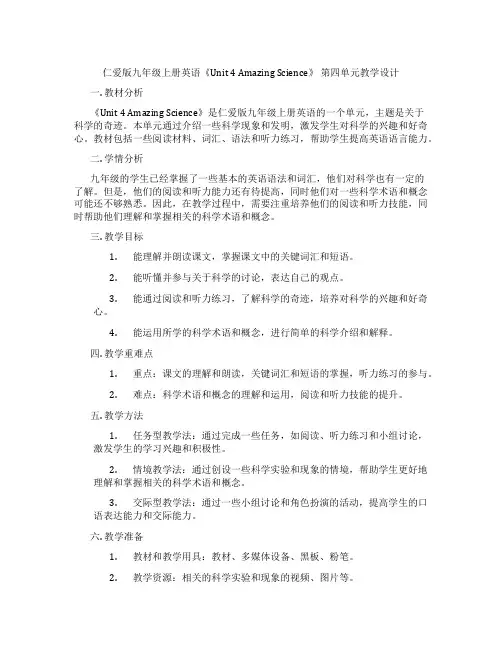
仁爱版九年级上册英语《Unit 4 Amazing Science》第四单元教学设计一. 教材分析《Unit 4 Amazing Science》是仁爱版九年级上册英语的一个单元,主题是关于科学的奇迹。
本单元通过介绍一些科学现象和发明,激发学生对科学的兴趣和好奇心。
教材包括一些阅读材料、词汇、语法和听力练习,帮助学生提高英语语言能力。
二. 学情分析九年级的学生已经掌握了一些基本的英语语法和词汇,他们对科学也有一定的了解。
但是,他们的阅读和听力能力还有待提高,同时他们对一些科学术语和概念可能还不够熟悉。
因此,在教学过程中,需要注重培养他们的阅读和听力技能,同时帮助他们理解和掌握相关的科学术语和概念。
三. 教学目标1.能理解并朗读课文,掌握课文中的关键词汇和短语。
2.能听懂并参与关于科学的讨论,表达自己的观点。
3.能通过阅读和听力练习,了解科学的奇迹,培养对科学的兴趣和好奇心。
4.能运用所学的科学术语和概念,进行简单的科学介绍和解释。
四. 教学重难点1.重点:课文的理解和朗读,关键词汇和短语的掌握,听力练习的参与。
2.难点:科学术语和概念的理解和运用,阅读和听力技能的提升。
五. 教学方法1.任务型教学法:通过完成一些任务,如阅读、听力练习和小组讨论,激发学生的学习兴趣和积极性。
2.情境教学法:通过创设一些科学实验和现象的情境,帮助学生更好地理解和掌握相关的科学术语和概念。
3.交际型教学法:通过一些小组讨论和角色扮演的活动,提高学生的口语表达能力和交际能力。
六. 教学准备1.教材和教学用具:教材、多媒体设备、黑板、粉笔。
2.教学资源:相关的科学实验和现象的视频、图片等。
七. 教学过程1.导入(5分钟)通过展示一些科学实验和现象的视频或图片,激发学生的兴趣和好奇心,引导学生进入学习状态。
2.呈现(10分钟)教师通过朗读课文,呈现本节课的主要内容和关键词汇。
在呈现过程中,引导学生跟读和模仿,提高他们的发音和听力技能。

Unit 1 The changing worldTopic 3 Section C备课思路:本课是第一单元第三话题的第三课时la・ld部分。
通过对阅读篇章的学习,掌握本课的单词、短语和句子。
本课在设计上注重对学生阅读能力的培养,为不同阅读方法的训练设计了不同层次的阅读题。
木课讲练结合,承上启下,环环相扣,由浅入深,帮助学生理解课文内容并习得目标语言。
本节课主要活动是la,因此对教学设计作如下安排:1.创设情境,引入新课。
呈现一组流浪者的图片,结合上节课的话题内容,与学生讨论关于流浪者的话题, 从而导入la内容。
2.目标明确,双向导学。
3・合作探究,提高能力・。
(1)Pre-reading:教师有意识的设置问题,例如为什么会流浪,居住在哪里,吃什么,有什么社会问题,如何去帮助他们等等,为阅读la做好铺垫。
(2)While-reading:①学生略读la,完成lb。
学生小组合作,自主阅读课文,找出新单词,短语及重点句型,教师帮助解决共性难点问题,为充分理解文章扫清障碍。
②精读:分段阅读,完成相应阅读任务,深入理解每段文意。
③听la录音,注意语音语调。
然后再读la,完成lc。
④播放la视频,进一步理解文章内容。
⑤分组阅读,完成Id.⑥根据lc内容复述课文4.解答疑问,点拨提升。
Language points.anguage points:• 1. Sometimes people are homeless because they have a problem with^ru gs or because they have a mental illness.有某方面的问题• 2. No one is everhomeless on Qumose.、没有人輕有《• 3. Whatever^Qe cause of homelessness is, the effects are也抚篩十“无论什么,不管什么,,,常用来引导从句,尤其是让步状语从句5・课堂检测,当堂达标。
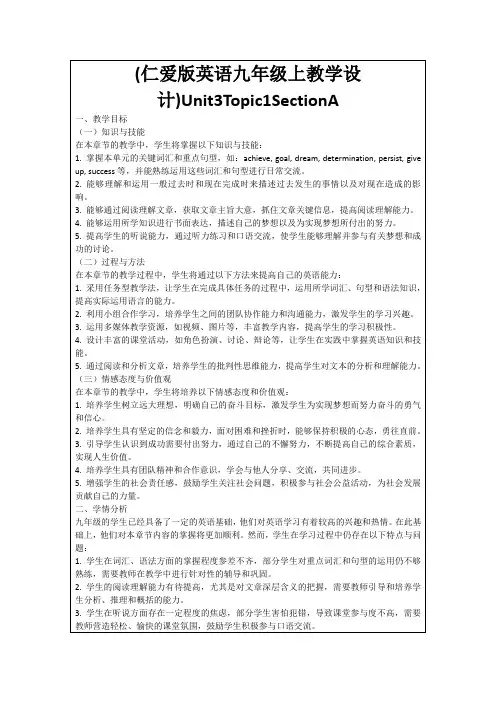
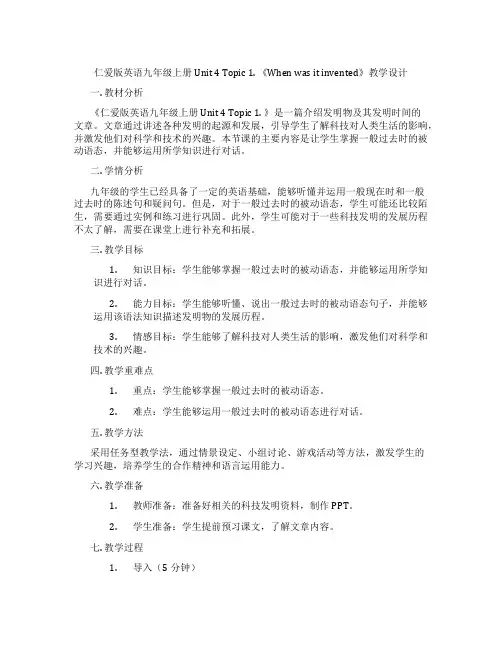
仁爱版英语九年级上册Unit 4 Topic 1. 《When was it invented》教学设计一. 教材分析《仁爱版英语九年级上册Unit 4 Topic 1. 》是一篇介绍发明物及其发明时间的文章。
文章通过讲述各种发明的起源和发展,引导学生了解科技对人类生活的影响,并激发他们对科学和技术的兴趣。
本节课的主要内容是让学生掌握一般过去时的被动语态,并能够运用所学知识进行对话。
二. 学情分析九年级的学生已经具备了一定的英语基础,能够听懂并运用一般现在时和一般过去时的陈述句和疑问句。
但是,对于一般过去时的被动语态,学生可能还比较陌生,需要通过实例和练习进行巩固。
此外,学生可能对于一些科技发明的发展历程不太了解,需要在课堂上进行补充和拓展。
三. 教学目标1.知识目标:学生能够掌握一般过去时的被动语态,并能够运用所学知识进行对话。
2.能力目标:学生能够听懂、说出一般过去时的被动语态句子,并能够运用该语法知识描述发明物的发展历程。
3.情感目标:学生能够了解科技对人类生活的影响,激发他们对科学和技术的兴趣。
四. 教学重难点1.重点:学生能够掌握一般过去时的被动语态。
2.难点:学生能够运用一般过去时的被动语态进行对话。
五. 教学方法采用任务型教学法,通过情景设定、小组讨论、游戏活动等方法,激发学生的学习兴趣,培养学生的合作精神和语言运用能力。
六. 教学准备1.教师准备:准备好相关的科技发明资料,制作PPT。
2.学生准备:学生提前预习课文,了解文章内容。
七. 教学过程1.导入(5分钟)教师通过提问方式引导学生回顾一般过去时的疑问句和陈述句,为新课的学习做好铺垫。
2.呈现(10分钟)教师通过PPT展示各种科技发明,引导学生用一般过去时进行描述。
然后,教师呈现课文内容,让学生听录音并跟读。
3.操练(10分钟)教师设计一些情境,让学生运用一般过去时的被动语态进行对话。
例如,教师可以设定一个情境,让学生扮演记者采访科学家,询问某种发明的发明时间和发明过程。
仁爱版英语九年级上册教学设计Unit3 Topic2Section A源城区光明学校王育芬教材分析:本单元围绕着世界语言——英语展开,谈到了英语的广泛应用、英语学习的重要性、不同国家应用应用英语的差异、英语的发展、手势语、英语学习策略。
这些话题与学生的英语学习息息相关、本课时主要呈现语法为现在进行时表将来的用法。
学情分析:对于九年级的学生来说,部分学生已经有了一定的英语学习基础,掌握了一点英,美国家日常生活中的不同传统特点,但总体上来说,还比较少.夏季课程安排与学生的生活紧密相连,也是他们很感兴趣的话题,如有机会,他们也想出国体验英美人家的风土人情,生活习惯。
基于现实生活,只能引导他们发挥自己丰富的想象力,把课堂模拟成生活,置身于学习之中,提高语言交际能力。
然而大部分学生对英美两国的旅游胜地,风土人情等了解甚少,因此词汇量偏大,加之大部分学生的英语成绩分化较严重,所以要求学生做好预习,借助网络和书籍,了解中英美之间生活的特点和差异,培养学生的自学能力。
在教师预设的任务中,注意引导学生在动态中生成。
这样就有利于学生更好地通过课本,达到英语的语言运用能力。
教学目标:1.初步学习现在进行时表示将来时的用法。
2.了解不同英语国家所讲英语的差异。
教学步骤:一.写出下面动词的过去式、过去分词和现在分词。
sink--- have--- lie---die--- run--- beat---hide--- win--- think---二.在文中划出下列短语并翻译。
I can’t follow you._________________ Australian English_________________ British English____________________ the same as _________________________be similar to_____________________call sb._____________________________English-speaking countries____________________________ instead of___________ put my suitcase in the trunk of the car_____________________________________by the way__________________depend on _______________differences between …and …________________________________be a little different from_________________ succeed in doing___________________ make yourself understood____________________ take one’s exam__________________ autumn\fall_______________________________ face to face___________________三、在文中找出下面的句子进行分析:1.Can you speak more slowly, please?译:________________________________________________________思考:有关“说”的词汇:_________(说话,说语言); _________(告诉,讲述);________(说…);__________(谈话)练习:a.Can you _________ English or Chinese? 译:______________________________________________b.He ________ that he had finished his task.译:_____________________________________________c.He is a funny man, he always ________ jokes to us. 译:______________________________________d.Let’s _________ about our plan, shall we? 译:_____________________________________________2. I just said hello to you.译:___________________________________点拨:say hello to sb.---给某人打招呼拓展: 给某人道歉__________________给某人告别__________________给某人道谢_____________________练习:1.因为我的错误我应对他说声抱歉。
仁爱版九年级英语UNIT4 Topic1 Section D 教学设计教材的分析本课处于仁爱英语九年级(上)Unit4 Amazing ScienceTopic1 Spaceships Are Mainly Controlled By Computers 第四课时,话题主要围绕谈论神舟五号和嫦娥一号进而涉及到电脑在航天中的应用。
本话题从令人关注的神五入手,贴近生活,时代感强。
然后,,由飞船的成功运行联想到电脑科技,最后,由电子邮件的发送与接收回到电脑的应用的实际生活中。
教学中本着整合教材的精神,把本课的内容顺序进行调整,使之浑然成为一个整体,因为学生在学习本课前已经学习并掌握了部分关于谈论电脑科技的的句型,所以,教材的要求与学生现有的水平相一致。
通过本课的学习,学生对祖国的科技有了更深的了解。
更乐于接触现代科技:电脑、太空知识,口语表达能力和书面表达能力都会有所提高。
学生分析:我所任教的中学,是以优异的教学成绩闻名远近的初级中学,学生在严格的教学管理中,形成了良好的学习习惯,对英语学习有较浓厚的兴趣,英语基础扎实,他们活泼、有好奇心、有创新精神。
他们争强好胜,渴望成功。
他们追逐新鲜事物,对电脑、手机、MP3、宇宙飞船都非常感兴趣,本教材的选择符合学生的心理特点,在学习本课之前,学生已经掌握了有关电脑在科技中的用途、优点和缺点,和一些基本的语法、单词和句型,已初步具备了小组合作学习的能力和语言表达能力。
教学目标1、知识目标(1) Review Grammar: The Object Complement.(2) Know about the parts of computers and the use of them.(3) Know about how to send and receive an e—mail.2、教学方法Task—based Language Teaching3、途径Listing, speaking, reading, writing, debiting,4、理论依据Project English 通过各种任务性的活动,巩固所学的语言知识;通过思考、体验、合作等方式来学习,培养学生独立思考的习惯以及口语表达和合作学习的能力,强化语言的运用和习得的过程,充分体现了语言的交际本质----- 学以致用(Learning to do things )。
5、辅助手段采用多媒体电脑投影图片、PPT 教学课件、充分利用网络资源;增大了课堂的容量;这样做是因为作为内驱动力的积极活跃的心理因素,对学习起到催化剂的作用,能大大提高学生对语言学习的兴趣和求知欲;这样能创设情景;活跃课堂气氛;营造语言氛围;吸引学生注意力;促进学生主动学习是课堂变得生动活泼、色彩鲜明、绚丽多彩是教学内容趣味化;提高英语教学的课堂教学效率。
重点:1. Sum up “Verb+ object+complement. ”2. Useful expressions.难点:Know about how to send and receive an e-mail.教具:Pictures, ppt, recorder, multimedia 教学方法:Speaking, listening, reading, talking, writing, debating.Teaching Procedure(教学过程):Step1. Review(5`)1. T: Good morning, everyone! I`m very happy to see you here today. Before class begins please look at the big screen. Talk about the pictures.(1)(Teacher shows the picture of Chang`e flying to the moon.)T: Who is she? Who can tell me?S1: She is Chang`e. She is a beautiful goddess. The ancient legend about her flying to the moon is known to all the Chinese.It shows ⋯(2)(show the picture of Yang Liwei)T: Who is he? what is she doing?S2:He is Yang Liwei, he is the first Chinese to travel into space.和i s our national hero. In 2003,he traveled around the earth in Shenzhou V for 21 hours ⋯All of us are very proud ⋯(3)(Show a picture of a computer.)T: What`s this?S3:It`s a computer.T: Do you know the name of every part of computers? Do youoften use computers? What do you use it for?S4:...chat with my friends.T: What about you?S5:..download the music and songs ⋯⋯shopping on line ⋯⋯watching movies ⋯⋯get info r mation ⋯T: Great, I often use the computer at home or at school as well,you know. To tell you a secret, I often use computers to sendand receive an e— mail. Do you know how to send and receivean e—mail? Let me tell you. Please come to 1a.(通过这一部分的内容,复习展示了2b 内容。
)Step2.Presention(10`)Listen to 1a and learn the new words and expressions:First paragraph(show some pictures.)turn on, connet to, evenlope, click on ⋯Second paragraph:click on “new”, “to ”,“subject ”“,s end”Third paragraph:“inbox ”“,a list of message click”o n “new message ” , finish reading ,go back to “inbox ”Step3 Consolidation(10`)1.Let students retell the steps of sending and receiving an—mail.2.Let students read 1a again and put the following picturesin the right order according to1a. Finish 1b.3.Let students send and receive an e-mail on the multimedia.Step4.Practice(12`)Divide the students into two groups, one is success group their opinion is: Computers are good things; the other is dreamgroup,their opinionis: Computers are bad things.(Debating the advantages and disadvantages.)Affirmative debater1:Computers have become every important in many areas of work and leisure. There is no doubt computers are very usefulin technology and business. So we think computers are good things.Negative debater1:Though computers improved our lives ,they have brought many problems, too. So we think computers are bad things.Affirmative debater2:In space, computers help the astronauts control the speed and direction of a spaceship`s flight. It proves computers are good things.Negative debater2:If we work on computers too much time ,we may get headache and sour eyes. Bad for our health, so computers are bad things.⋯⋯According to the SectionA---- SectionC, debating the uses of computers and disadvantages of computers .T :sum up:Well done! everyone! I think all of us want to know which group will win, I tell you they both win, because they agued are both sides of one problem, computers are good things becausethey are one of the great inventions in the 20th century, helping human beings in many ways; computers are bad things because they can cause many problems. We must use computers properly, make them serve us better 呈现2a⋯句(子,适时对学生进行思想教育。